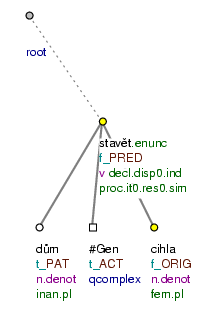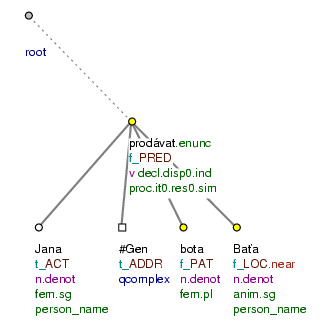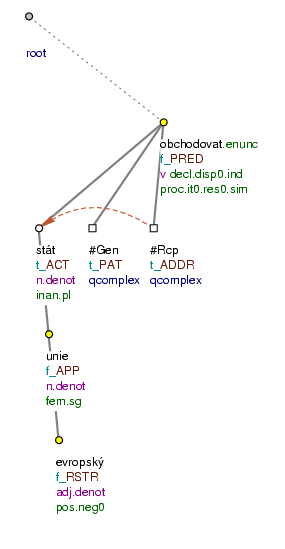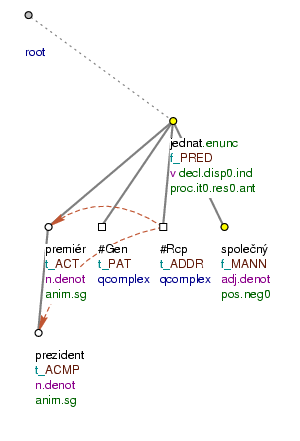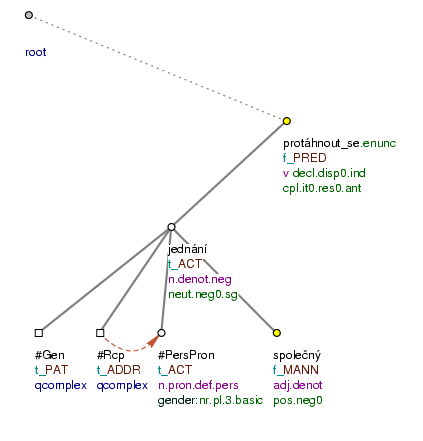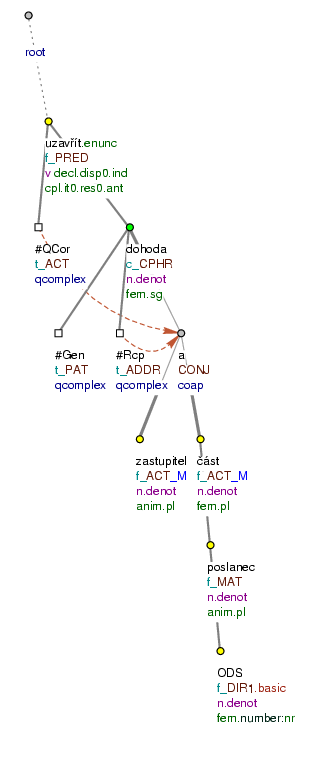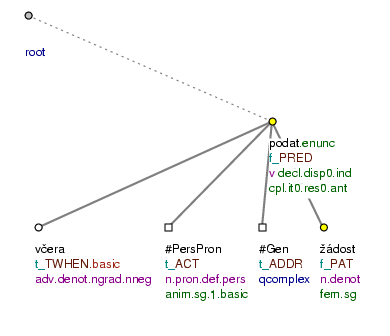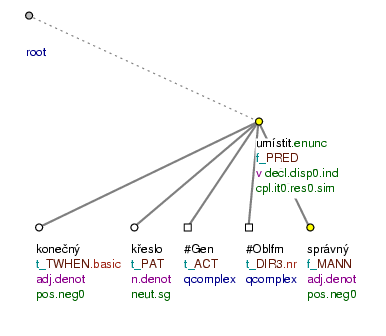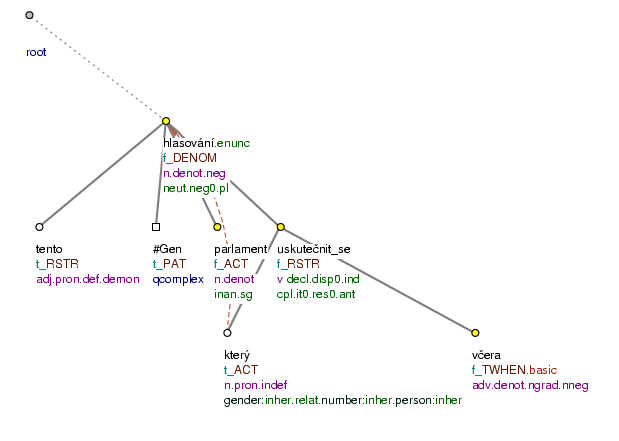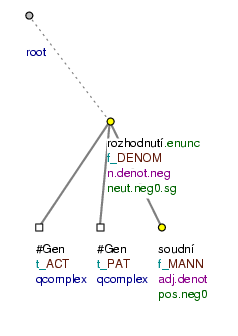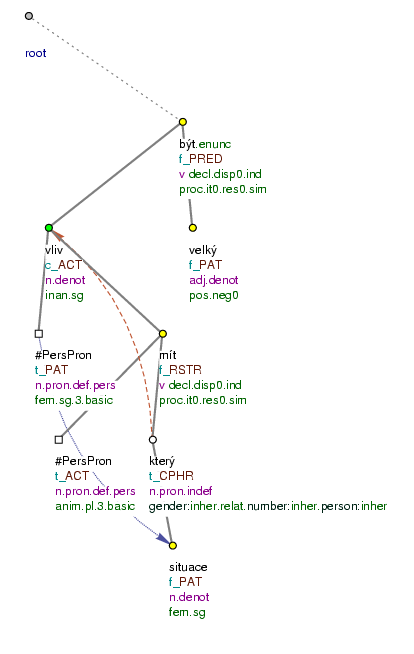In this section, it is described how - on the basis of their valency frames - the valency of individual nodes is represented in the tectogrammatical trees.
The valency of a node is represented in a tectogrammatical tree in the following way:
-
by assigning the node an adequate valency frame (from the valency lexicon). The
val_frame.rfattribute contains the identifier assigned to the valency frame corresponding to the given meaning of the given word. -
by filling in the valency frame in the tectogrammatical tree. Filling in the valency frame in a tectogrammatical tree means assigning functors to dependent valency modifications (according to the assigned valency frame) and generating new nodes for those obligatory modifications that are not present at the surface level of the sentence.
Nodes for non-expressed optional valency modifications (i.e. those absent at the surface level) are not added (newly generated) to the structure (see Section 2.4.1, "General arguments and unspecified Actors"). The only reason for adding a node for an absent optional argument into the structure is to enable the proper representation of the (grammatical) coreference relations.
Valency, as understood on the tectogrammatical level, is a matter of meaning; therefore, valency modifications do not have to be expressed (nor expressible) at the surface level of a sentence. The rules for adding a new node - for an obligatory modification - into a tectogrammatical tree are described mainly in Section 12.2, "Ellipsis of the dependent element".
In this section, only two specific cases (when a valency modification is not expressed) are discussed :
-
the case when an argument is not expressed because it has a generalized meaning or when the Actor is unspecified (see Section 2.4.1, "General arguments and unspecified Actors"),
-
the case when a valency modification is not expressed because reciprocity is involved (see Section 2.4.2, "Reciprocity").
The last section (Section 2.4.3, "Some directions for representing the valency of individual complex nodes") summarizes the rules for valency annotation in the tectogrammatical trees.
!!! The present state of valency representation in PDT. Not every valency behavior is represented properly in the tree structures. Valency is represented properly for the following groups of complex nodes:
-
for all semantic verbs,
-
for all semantic verbal nouns (ending with -ní and -tí) that are included in the valency lexicon.
-
for all semantic nouns that represent the nominal part of a complex predicate (i.e. for all semantic nouns with the
CPHRfunctor). -
for all semantic adverbs included in the valency lexicon
The groups of nodes just mentioned are called "checked nodes" (meaning: with respect to the representation of their valency); other nodes are called "unchecked nodes".
!!! For the checked nodes it can be guaranteed that:
-
they are assigned the appropriate valency frame. The value in the
val_frame.rfattribute is valid (which might not be the case with unchecked nodes). -
their valency frames are filled in, i.e. the dependent modifications are assigned the appropriate functors and new nodes are generated if necessary (i.e. nodes for non-expressed obligatory modifications). See the rules in Section 12.2, "Ellipsis of the dependent element".
As for newly established nodes for obligatory modifications of nouns and adverbs, often, the correct t-lemma substitute was not chosen (i.e. the one corresponding to the given type of coreference; see Section 12.2.1, "Ellipsis of an obligatory modification"). Newly established nodes were assigned the provisional t-lemma substitute
#Gen(the t-lemma used for general arguments; see Section 2.4.1, "General arguments and unspecified Actors"). The#Gent-lemma assigned to valency modifications of nouns and adverbs signals that the correct value has not been decided yet; generally, the correct t-lemma can be any of the following:#Gen,#PersPron,#Coror#QCor. Nodes that have not been assigned the appropriate t-lemma yet and still have the#Gent-lemma, may also lack the proper representation of their possible coreference relations. If a newly established node for an obligatory valency modification of a noun or adverb has a t-lemma other than#Gen, it means that the value of the t-lemma has already been decided (and assigned properly) and their coreference relations (if any) are represented properly as well.
!!! As for the unchecked nodes, it cannot be guaranteed that their valency is represented properly. It can be stated:
-
as for unchecked nodes, the valency lexicon may but need not contain their valency frames (they might not be constituted).
-
the unchecked nodes may but need not have their
val_frame.rfattribute filled in. If the attribute is filled, its value is always only provisional. -
the unchecked nodes may have arguments as their dependent nodes. It could happen that - when determining the valency frames of such nodes - the original value of an argument was changed to another or it was decided that the valency frame is empty (
EMPTY). However, the possible changes are not necessarily reflected in the tectogrammatical trees. The functor assigned to a node dependent on an unchecked node has always only a provisional value. The same applies to newly established nodes dependent on the unchecked nodes. -
as for newly established nodes dependent on the unchecked nodes, all values of all attributes are provisional (esp. their t-lemmas and functors); even the appropriateness of adding the node into the structure might be questioned. After a thorough check on valency representation in PDT, the node need not be present in the tree at all.
A summary of different cases of valency modification ellipses is given in Section 12.2, "Ellipsis of the dependent element".
The present section provides a discussion of certain specific cases of valency modifications missing at the surface level (the semantic obligatoriness of these modification in fact enables the ellipsis). These are:
-
general arguments.
-
unspecified Actors.
General arguments. The term general argument is used for a modification (absent at the surface level) that does not refer to a concrete entity (which is the case with common ellipses) but it is rather a type of modification usual in the given position. The lexical content of the argument has to be the usual one for the given verb (noun, adjective) in the given position in order for the argument to become general. The fact that a modification has such a general meaning allows for omitting it in the surface structure.
In a tectogrammatical tree, the general argument is assigned a newly established node with the #Gen t-lemma. General arguments refer to "entities usual or typical in the given situation"; therefore, it is impossible to indicate any coreference relations in which the general argument might take part.
Both obligatory and optional arguments can become general. If an obligatory argument is absent at the surface level and it is not the case of common ellipsis (nor is it an unspecified Actor; see further) it means that we deal with a general argument.
General obligatory arguments, not present at the surface, are always assigned a newly established node with the #Gen functor in the tree.
Examples of general arguments:
-
general Actor:
-
Domy se stavějí z cihel. {
#Gen.ACT} (=Houses are built from bricks; lit. Houses REFL build from bricks)The valency frame for the given meaning of the verb stavět (=build):
ACT(.1)PAT(.4) ?ORIG(z+2)Cf. Fig. 6.1.
A typical surface form of a structure with the general Actor is the reflexive passive. If the periphrastic passive is used instead, it may signal the presence of the general Actor but it also may be the case that the speaker has a specific Actor in mind but the Actor is omitted as it is recoverable from the context. In such cases the t-lemma assigned to the newly established node is
#PersPron -
-
general Patient:
-
V téhle troubě se mi dobře peče. {
#Gen.PAT} (=I can bake easily in this oven; lit. In this oven REFL me well bakes.)The valency frame for the given meaning of the verb péci (=bake):
ACT(.1)PAT(.4) ?ORIG(z+2)
-
-
general Addressee:
-
Jana prodává boty u Bati. {
#Gen.ADDR} (=Jana sells shoes at Bata)The valency frame for the given meaning of the verb prodávat (=sell):
ACT(.1)PAT(.4)ADDR(.3)Cf. Fig. 6.2.
-
-
general Effect:
-
Napiš mu o tom. {
#Gen.EFF} (=Write him about it)The valency frame for the given meaning of the verb napsat (=write):
ACT(.1) ?PAT(o+6) ?ADDR(.3)EFF(.4;že[.v];aby[.v];.s)
-
-
general Origo:
-
Učinil předčasný závěr. {
#Gen.ORIG} (=He made a premature conclusion)The valency frame for the given meaning of the verb učinit (=make):
ACT(.1)CPHR({závěr,shrnutí,...}.4)ORIG(z+2)
-
!!! If an optional argument is absent at the surface level the reason could be its optionality - we are not necessarily dealing with a general argument. However, there are no reliable criteria for distinguishing these two cases yet. For this reason, if an optional argument is absent at the surface level we consider this to be a consequence of its optionality and no new nodes are added to the structure. The only reason for adding a node for an absent optional argument into the structure is to enable the proper representation of the (grammatical) coreference relations.
!!! In principle, all valency modifications may become general. Nevertheless, we only talk about general arguments (and not general obligatory free modifications) so far. Obligatory free modifications absent at the surface level are assigned a newly established node with the #Oblfm t-lemma (see also Section 12.2.1.3, "Ellipsis of an obligatory free modification (t-lemma substitutes #Oblfm and #Rcp)"); the question whether they have the general meaning in some cases is left open.
!!! NB! The #Gen t-lemma is assigned correctly only in the case of (ad)verbal modifications. As for newly established nodes for arguments of nouns, adjectives and adverbs, the correct t-lemma substitute often has not been chosen (i.e. the one corresponding to the given type of coreference relations; see Section 12.2.1, "Ellipsis of an obligatory modification"). The provisional t-lemma assigned to these nodes is #Gen. The #Gen t-lemma assigned to valency modifications of nouns, adjectives and adverbs signals that the correct value has not been determined yet; generally, the correct t-lemma can be any of the following: #Gen, #PersPron, #Cor or #QCor. Nodes that have not been assigned the appropriate t-lemma yet and still have the #Gen t-lemma, may also lack the proper representation of possible coreference relations.
Unspecified Actor. Apart from the cases of common ellipsis on the one hand and general arguments on the other, there is also the transitory case of so called unspecified Actor. This involves cases when a modification absent at the surface level denotes an entity more or less known from the context which is however not explicitely referred to. The entity corresponding to the non-expressed Actor cannot be precisely determined, the absent Actor refers rather to the preceding context than to a particular lexical unit; nevertheless, it is possible to specify the class of entities it refers to at least partially.
When determining whether the non-expressed Actor in question is unspecified or not, one can use the information provided by the form of the sentence. There are certain signals indicating that the non-expressed argument is an unspecified Actor:
-
typical surface form of the sentence:
-
the governing verb agrees with the null subject in 3rd person plural animate.
-
typically, a locative adverbial is present, providing certain information as to the identity of the entities (usually people) among which we may search for the Actor:
Na poště.
LOCzavírají v šest hodin odpoledne (=lit. At post-office close.3pl. at six o'clock in_the_afternoon).Tady.
LOCdobře vaří (=lit. Here well cook.3pl.).
-
-
the possibility to specify the referrent
-
exclusion of the speaker from the class of possible Actors
The unspecified Actor is assigned a newly established node with the #Unsp t-lemma in the tree. Neither the #PersPron t-lemma (which has a clear anaphoric reference), nor the #Gen t-lemma (which refers to typical referents) is assigned to unspecified Actors.
Examples:
Zmizení tohoto 700 kg těžkého lékařského přístroje hygienikům ohlásili 30. června letošního roku. {#Unsp.ACT} (=lit. Disappearance (of) this 700 kg heavy medical apparatus to_hygienists announced.3pl.anim 30th June this year; i.e.: They announced that...) Fig. 6.3
Hlásili to v rozhlase. {#Unsp.ACT} (=lit. Announced.3pl.anim it on radio) Fig. 6.4
(Co jste dělal mezitím? Začít tehdy samostatně režírovat na Barrandově bylo absolutně nemyslitelné.) Ale přijali mě do scénáristického oddělení. {#Unsp.ACT} (= (What did you do in between? It was absolutely unthinkable for me to start doing my own films at Barrandov at that time.) But I was accepted to the scriptwriting department; lit. But accepted.3pl.anim me to scriptwriting department)
Vypnuli proud. {#Unsp.ACT}(=lit. Switched_off.3pl.anim electricity)
Ukradli nám auto. {#Unsp.ACT} (=lit. Stole.3pl.anim us car)
Figure 6.3. Unspecified Actor.
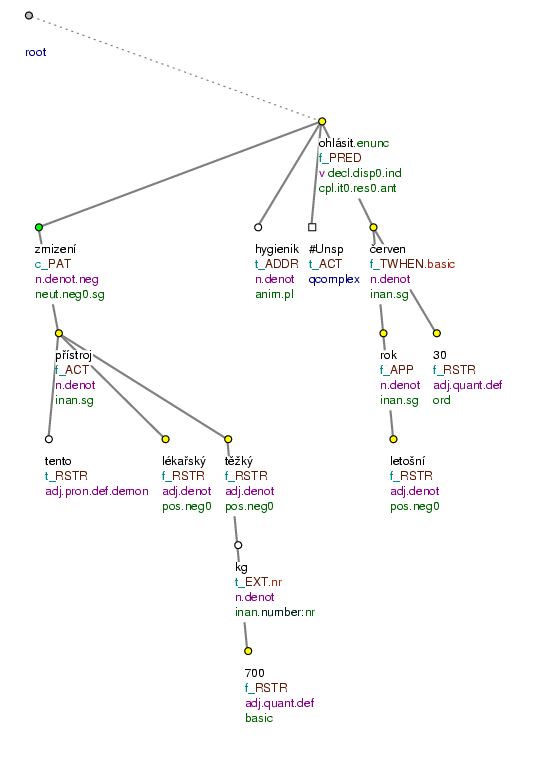
Zmizení tohoto 700 kg těžkého lékařského přístroje hygienikům ohlásili 30. června letošního roku. (=lit. Disappearing (of) this 700 kg heavy medical tool (to) hygienists (they) announced 30the June this year)
!!! Apparently, any argument may be unspecified (also with nouns, adjectives and adverbs). However, it is not easy to propose criteria for distinguishing the cases when a node with the #Gen t-lemma should be added to the structure from the cases when the appropriate t-lemma is #Unsp and these from cases with exophoric coreference relations, i.e. cases when a node with the #PersPron t-lemma should be added (see Section 3.1.3, "Exophora"). Only in the case of unspecified Actor the form of the sentence helps us; with all other arguments (and especially with nominal and adjectival arguments), the only lead is the possibility to specify the referent (as opposed to the cases of general arguments which lack this possibility). Due to these difficulties, only cases of unspecified Actors of verbs are indicated in the tectogramamtical trees.
Borderline between the general and unspecified Actor. Differences between general and unspecifed Actors are summarized in Table 6.2, "The borderline between general and unspecified Actor".
Table 6.2. The borderline between general and unspecified Actor
| Exclusion of the speaker | Typical surface form (of the sentence) | Specifying the referent | |
|---|---|---|---|
|
General Actor ( |
we do not know | reflexive passive | all referents typical for a given situation |
|
Unspecified Actor ( |
yes | the verb is in the 3pl animate | the class of people (referents) is not specified explicitely but it is possible to deduce a possible referent from the context |
!!! The rules for representing reciprocity have been changed many times and even the present version is probably not final. Reciprocity is not analyzed in a completely consistent way in the data. Nor are all the cases involving reciprocity identified. Reciprocity is not consistently represented especially in those cases where none of the valency modifications involved in the reciprocal relations is the Actor. These cases were not (unlike the cases involving Actors) checked after the first phase of the annotation.
The term reciprocity is used for the syntactic operation on valency frames that puts two different valency modifications (arguments or obligatory adjuncts) in a symmetric relation, which can be expressed in the following way:
-
Jan a Marie se setkali. (=Jan and Marie met) = Jan se setkal s Marií a (zároveň) Marie se setkala s Janem. (=Jan met Marie and (simultaneously) Marie met Jan)
An important condition for reciprocity to be possible, the two valency modifications have to be homogeneous. For example, in the following case, the same paraphrase cannot be used:
-
Pavel se setkal s nezájmem. (=lit. Pavel met indifference) ≠ Pavel se setkal s nezájmem a (zároveň) nezájem se setkal s Pavlem. (=lit. Pavel met indifference and (simultanously) indifference met Pavel)
As a result of the presence of reciprocal relations in a sentence, one of the obligatory modification positions is lost at the surface level (usually the Patient position). Another position (usually the Actor position) is occupied by both modifications (standing in the reciprocal relation) at the same time. Semantically, however, they correspond to two different valency positions (usually these are the Actor and Patient positions). The form of the position containing the modifications in the reciprocal relation is:
-
coordination.
Cf.:
-
Jan.
ACTa Marie.ACTse potkali. (=Jan and Marie met each other)= Jan.
ACTpotkal Marii.PATa (zároveň) Marie.ACTpotkala Jana.PAT(=Jan met Marie and (simultaneously) Marie met Jan)
-
-
the noun phrase is in plural (or it has the plural semantics)
For example:
Dvojice se líbala. (=The couple kissed)
Milenci se líbali. (=The lovers kissed)
-
the form s+7.
For example:
Jan s Marií se líbali. (=lit. Jan with Marie REFL kissed)
-
coordination inside the prepositional phrase mezi+7 (see Section 2.4.2.3, "Reciprocity with nouns").
For example:
V pondělí se konala zajímavá diskuze mezi čtenáři a spisovateli o smyslu literatury. (=lit. On Monday took_place interesting discussion between readers.INSTR and authors.INSTR on sense (of) literature)
Some verbal meanings allow for reciprocity, others do not. The basic condition for reciprocal relations to be established is the homogeneity condition on the relevant valency modifications. Cf.:
-
valency frames of the verb setkat se (meet):
-
ACT(.1)PAT(s+7)setkal se s přítelem (=he met with a friend)
-
ACT(.1)PAT(s+7)setkal se s potřebou (=lit. (he) encountered/met with need), s. se s nezájmem (=...with indifference), s. se s nepřátelstvím (=...with hostility)
-
!!! Not many valency frames (identical at first sight) are distinguished in this way. Most verb have only one valency frame, which is assigned both to the verbs with homogeneous and non-homogeneous valency modifications.
As for the verbs where there are two competing forms for the Patient argument, the accusative and the prepositional phrase s+7, two valency frames are distinguished - one with the prepositional phrase Patient (s+7) (which has a potential reciprocal meaning) and one with the accusative Patient (which may get the reciprocal meaning only after the appropriate transformation). When the construction involves reciprocity, the verb is assigned the valency frame with the accusative Patient. Cf.:
-
Pavel se viděl s Petrem.
PATv divadle. (=lit. Pavel REFL saw.3sg with Petr in theater)The valency frame:
ACT(.1)PAT(s+7) (.[se]) -
Pavel viděl Petra.
PATv divadle. (=Pavel saw Petr in the theater)The valency frame:
ACT(.1)PAT(.4,.2,že[.v],jak-2[.v],jestli[.v],zda[.v],.c) -
Pavel a Petr se viděli v divadle. {
#Rcp.PAT} (=Pavel and Petr saw each other in the theater; lit. Pavel and Petr REFL saw...)The valency frame:
ACT(.1)PAT(.4,.2,že[.v],jak-2[.v],jestli[.v],zda[.v],.c)
!!! The solution based on distinguishing two different valency frames (one with the Patient in the form of the prepositional phrase s+7, the other with the accusative Patient) is only temporary. It is necessary to consider again carefully the relations between the reciprocal and non-reciprocal meanings and the surface forms of the relevant valency modifications.
Reciprocal "se". With respect to reciprocity, three different kinds of se are distinguished:
-
"se" as part of the t-lemma of a verb.
With inherently reciprocal verbs like setkat se (=meet), hádat se (=argue), prát se (=fight) (it is assumed that the second argument is active in the event) se is taken to be part of their t-lemma (complex t-lemma, see Section 3.1, "Multi-word t-lemma"). The verb cannot be used without the reflexive.
The surface-form specification in the valency frame does not contain se, then.
-
"se" as a result of expressing the Patient by means of the prepositional phrase "s+7".
Verbs the Patient (or Addressee) of which is expressed by the prepositional phrase s+7, combines with se as a (surface) result of expressing the Patient by means of the prepositional phrase s+7. The corresponding valency frame has the following form, then:
PAT(s+7) (.[se])Cf.:
-
Petr se potkal s Pavlem.
PAT(=lit. Petr REFL met with Pavel)The valency frame:
ACT(.1)PAT(s+7) (.[se])
-
-
"se" as a formal means of expressing reciprocity.
With transitive verbs, reciprocity is regularly signalled (at the surface level) by se, which is not specified, then, in the valency frames (see Section 2.2.3, "Productive changes in the surface form (not specified in the valency frames)"). Cf.:
-
Petr potkal Pavla.
PAT(=Petr met Pavel)Petr a Pavel se potkali.{
#Rcp.PAT} (=Petr and Pavel met)The valency frame:
ACT(.1)PAT(.4)
Se (k sobě, mezi sebou) is considered a formal means of expressing reciprocity also with other than transitive verbs. The surface-form specifications in the corresponding valency frames do not contain the information (as it is a regular means of expressing reciprocity).
-
A typical form used for expressing reciprocity with nouns is the form mezi+7 (=between/among + instrumental). The form mezi+7 is not included in the list of possible surface forms of the argument; it is a regular way of expressing reciprocity (see also Section 2.2.3, "Productive changes in the surface form (not specified in the valency frames)"). Cf.:
-
jednání vlády.
ACTs prezidentem.ADDR(=lit. negotiations (of) government with president)jednání vlády.
ACTa prezidenta.ACT{#Rcp.ADDR} (=lit. negotiations (of) government and president)jednání mezi vládou.
ACTa prezidentem.ACT{#Rcp.ADDR} (=lit. negotiations between government and president)The valency frame:
ACT(.2,.u)PAT(o+6,ohledně[.2],věc:/AuxP[v-1,.2],v-1[věc.6[tento.#]],jestli[.v],aby[.v])ADDR(s+7)
Reciprocity is represented by means of inserting a newly established node with the #Rcp t-lemma into the structure, in the position of the valency modification that was left out (at the surface level) as a result of participating in the reciprocal relation. The newly established node has the functor corresponding to the unoccupied valency position. The relation between the newly established node (t_lemma=#Rcp) and the valency modification containing both members of the relation is indicated in the tree as a case of grammatical coreference (see Section 2.6, "Coreference in constructions with reciprocity"). Cf.:
-
Jan.
ACTa Marie.ACT<se> líbali. {#Rcp.PAT} (=Jan and Marie kissed)The Actor and Patient of the verb líbat are in the reciprocal relation. Both arguments occupy the Actor position and the Patient position is left unoccupied as a result of being in the reciprocal relation. A newly established node with the
#Rcpt-lemma is inserted into the structure in the Patient position (it is assigned thePATfunctor). The grammatical coreference relation between the Actor and Patient is indicated in the tree - in this case, it connects the node with the#Rcpt-lemma with the node assigned to to the conjunction a (=and). Cf. Fig. 6.5.
If none of the valency modifications taking part in the reciprocal relation is an Actor, the position occupied by both members of the relation is assigned the functor that precedes the other one (taking part in the reciprocal relation) in the valency frame (the surface form of the expressed valency modification corresponds to the surface form of the assigned functor). For example, if a verb has the Actor, Patient and Effect in its valency frame and there is a reciprocal relation between the Patient and Effect, the expressed valency position is assigned the PAT functor and the newly established node with the #Rcp t-lemma is assigned the EFF functor. Cf.:
-
Porovnávali Německo.
PATa Koreu.PAT{#Rcp.EFF} (=The compared Germany and Korea)The valency frame:
ACT(.1)PAT(.4)EFF(s+7)There is a reciprocal relation between the Patient and the Effect of the verb porovnávat in the sentence. Both arguments occupy the Patient position and the Effect position is left unoccupied as a result of the arguments being in the reciprocal relation. A newly established node with the
#Rcpt-lemma is inserted into the structure in the Effect position (it is assigned theEFFfunctor). The grammatical coreference relation between the Patient and Effect is indicated in the tree.
More examples:
Němce.PAT odděluje rozdílná mentalita. {#Rcp.ORIG} (=lit. Germans.ACC separates different mentality.NOM, i.e. Germans are not united due to the fact that they have different mentality)
Ukrajina chce sjednotit rozdílné směnné kurzy.PAT své měny. {#Rcp.ADDR} (=lit. Ukraine wants to unify different parities (of) its currency)
Similarly, if a verb has the following valency modifications: ACT, PAT, DIR1 and DIR3 and there is a reciprocal relation between the DIR1 and DIR3 modifications, the expressed valency position is assigned the DIR1 functor and the newly established node with the #Rcp t-lemma is assigned the DIR3 functor; for example:
Poslanci přehazují návrh zákona mezi klubem.DIR1a sněmovnou.DIR1 {#Rcp.DIR3} (=lit. Members_of_Parliament shift bill between club and chamber) Fig. 6.6
Formal means of expressing reciprocity. The fact that there is a reciprocal meaning in a sentence is usually signalled by the presence of se (k sobě, mezi sebou), nevertheless it is not a necessary condition for the construction to be interpreted as involving reciprocity. Se, possibly present at the surface level, is not represented by a separate node at the tectogrammatical level; reference to the relevant analytical node(s) is included in the a attribute of the newly established node with the #Rcp t-lemma. For example:
Státy.ACT Evropské unie <mezi sebou> obchodují. {#Rcp.ADDR} (=lit. States (of) EU between themselves trade) Fig. 6.7
Dvojice.ACT <se> fyzicky napadla. {#Rcp.PAT} (=lit. Couple REFL physically attacked; meaning each other)
NB! Adverbials like navzájem, vzájemně (=mutually), spolu (=together) are always represented by a separate node (the functor being usually MANN). E.g.:
Premiér s prezidentem spolu.MANN jednali. (=lit. Prime_minister with president together negotiated) Fig. 6.8
NB! Reciprocal relations are only represented in the tectogrammatical trees in case this affects valency positions, i.e. in case there is an obligatory valency modification non-expressed (a valency position unoccupied).
As for constructions where all valency positions are occupied but where we can detect a reciprocal relation anyway (this concerns mainly inherently reciprocal verbs), the reciprocity is not represented in the tectogrammatical tree at all; this applies e.g. to the following constructions:
Sourozenci.ACT se po sobě.LOC válejí [válet_se.PRED] (=lit. Siblings REFL on each_other roll)
Sousedé.ACT si.BEN navzájem.MANN natřeli plot (=lit. Neighbors REFL mutually/to_each_other painted fence).
Petr.ACT potkal Pavla.PAT (=Petr met Pavel)
Sestra.ACT si dopisuje s přítelem.ADDR [ dopisovat_si.PRED] (=lit. Sister REFL corresponds with friend)
Reciprocal relations between nonobligatory adjuncts are not represented in any way either.
Reciprocity in constructions where all valency positions are occupied (lexically specified) is always only potential. There may be a very strong tendency to interpret the construction as involving reciprocity; however, it is not the only interpretation available (not even for the inherently reciprocal verbs). An appropriate context may cancel out the (potential) reciprocal interpretation. Cf.:
-
Pavel se hádá s Janou. (=lit. Pavel REFL argues with Jana)
-
Pavel se často hádá s Janou. (=lit. Pavel REFL often argues with Jana)
With respect to reciprocity, especially those constructions are problematic that allow for expressing the Patient (or Addressee) by means of either the accusative case or the prepositional phrase s+7. The following overview lists the differences in representing these constructions:
-
Jan líbal Marii. (=Jan kissed Marie)
The accusative Patient constructions do not have the reciprocal interpretation.
The assigned valency frame:
ACT(.1)PAT(.4) -
Jan se líbal s Marií. (=lit. Jan REFL kissed with Marie)
The constructions with the prepositional phrase Patient (s+7) are potentially reciprocal, i.e. they may but need not have the reciprocal interpretation. An appropriate context may cancel out the reciprocal interpretation (for example: Jan se líbá s Marií rád. (=lit. Jan REFL kisses with Marie with_pleasure; i.e. Jan likes to kiss Mary))
Since the reciprocal interpretation is not inevitable and since all the valency positions are occupied, constructions of this type are not represented as involving reciprocity in the tectogrammatical trees.
The assigned valency frame:
ACT(.1)PAT(s+7) (.[se]) -
Jan a Marie se líbali. (=lit. Jan a Marie REFL kissed)
The unoccupied Patient position, se and the coordination in the Actor position are clear signals that there is a reciprocal relation between the Actor and Patient in the sentence. A new node with the
#Rcpt-lemma is inserted into the structure, taking up the position of the absent Patient (cf. Fig. 6.5).The assigned valency frame:
ACT(.1)PAT(.4) -
Jan a Marie se líbali. (=lit. Jan a Marie REFL kissed.pl) / Jan s Marií se líbal. (=lit. Jan with Marie REFL kissed.sg)
The constructions where both (potential) members of the valency frame are present in the sentence and the second one is expressed by the prepositional phrase s+7 are assigned an analysis depending on the agreement suffix on the verb:
-
if the verb has the plural agreement suffix, the construction is considered to involve reciprocity, just like in Jan a Marie se líbali (=lit. Jan and Marie REFL kissed.pl), the difference being that there is no coordination in the Actor position; instead the two members of the reciprocal relation have the form A with B. A new node with the
#Rcpt-lemma is inserted into the structure, in the Patient position.The assigned valency frame:
ACT(.1)PAT(.4) -
if the verb has the singular agreement suffix, the construction is interpreted as involving no reciprocity, on a par with Jan se líbal s Marií (=lit. Jan REFL kissed.sg with Marie). The construction does not have to be interpreted as involving reciprocity. An appropriate context may cancel out the reciprocal interpretation (cf.: Jan s Marií se líbal rád. (=lit. Jan with Marie REFL kissed.sg with_pleasure). Since it is not necessary to interpret the construction as involving reciprocity, the modification of the form s+7 is analyzed as depending directly on the verb and it is assigned the
PATfunctor.The assigned valency frame:
ACT(.1)PAT(s+7) (.[se])
-
Reciprocal vs. reflexive constructions. Ambiguous constructions where se can be analyzed either as the formal means of expressing reciprocity or as a reflexive pronoun occupying a valency position (the reflexive signals the identity in reference with the closest subject) are disambiguated by assigning the construction either the reciprocal or the reflexive interpretation. Cf.:
-
Eva a Jana se natřely opalovacím krémem. (=lit. Eva and Jana REFL put_on suntan lotion)
= Eva natřela Janu a Jana natřela Evu (=Eva rubbed some suntan lotion onto Jana's skin and the other way round; reciprocal interpretation).
= Eva natřela sebe a Jana natřela sebe (=Eva rubbed some suntan lotion onto her own skin and Jana did the same to herself; reflexive interpretation).
If the construction is interpreted as involving reciprocity, se is not assigned a separate node - the reference to it is contained in the
aattribute of the newly established node with the#Rcpt-lemma and thePATfunctor. If the construction is to be interpreted reflexively, se is assigned a separate node with thePATfunctor.
Multiple reciprocity. There may be multiple reciprocal relations involved in one construction. Cf.:
-
Jan a Pavel spolu hovořili o sobě navzájem. (=Jan and Pavel talked together about each other)
There is a reciprocal relation between the Actor and Addressee and also between the Actor and Patient. It is necessary, then, to insert two new nodes with the
#Rcpt-lemma into the structure, one in the Patient, the other one in the Adressee position (the reference to the prepositional phrase o sobě is contained in theaattribute of the newly established node for the Patient). -
Jan a Pavel spolu hovořili (každý sám) o sobě. (=Jan and Pavel talked together, each about oneself)
There is only one reciprocal relation in the sentence - the one between the Actor and the Addressee. The prepositional phrase o sobě has the reflexive meaning here. Only one new node with the
#Rcpt-lemma is inserted into the structure; the node representing the prepositional phrase o sobě is assigned thePATfunctor.
Figure 6.6. Reciprocity
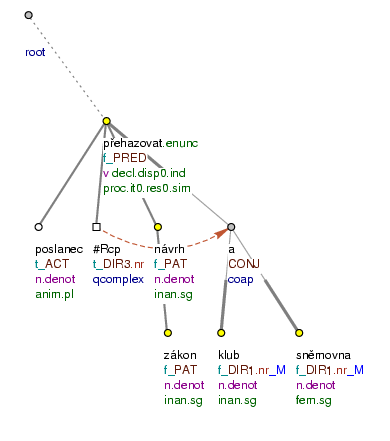
Poslanci přehazují návrh zákona mezi klubem a sněmovnou. (=lit. Deputies throw_over bill - between club and parliament)
Also valency modifications of nouns (and not only the deverbal ones) take part in reciprocal relations. Examples of nouns valency modifications of which may take part in reciprocal relations :
bitva (=battle), boj (=fight), dohoda (=agreement), dialog (=dialogue), domluva (=agreement), duel (=duel), jednání (=negotiation), komunikace (=communication), obchod (=trade), porovnání (=comparison), setkání (=meeting), sjednocení (=unification), utkání (=match), vztah (=relation)
When representing reciprocity with nouns the same rules are followed as when verbal constructions are analyzed. Cf.:
-
jednání Petra.
ACTa Pavla.ACTo prodeji domu trvalo několik hodin. {#Rcp.ADDR} (=lit. negotiations (of) Petr and Pavel about sale (of) house took several hours)= Petr negotiated with Pavel and (simultaneously) Pavel negotiated with Petr
The valency frame for the given meaning of the noun jednání (=negotiation):
ACT(.2;.u)PAT(o+6,ohledně[.2],věc:/AuxP[v-1,.2],v-1[věc.6[tento.#]],jestli[.v],aby[.v])ADDR(s+7)As a result of expressing the reciprocal relation, the Addressee position is not occupied (at the surface level). A newly established node with the
#Rcpt-lemma is inserted into the structure and it is assigned theADDRfunctor. It is indicated that there is a grammatical coreference relation between the newly established node and the Actor position (which is occupied by both members of the reciprocal relation at the same time) (see Section 2.6, "Coreference in constructions with reciprocity"; cf. Fig. 6.9).
Like with verbs, the fact that there is a reciprocal meaning between some of the nominal modifications is signalled by the presence of se (mezi sebou, k sobě) in the sentence. These formal means of expressing reciprocity, possibly present at the surface level, are not represented by separate nodes at the tectogrammatical level; reference to the relevant analytical nodes is included in the a attribute of the newly established node with the #Rcp t-lemma. For example:
Jednání států <mezi sebou> bylo přerušeno. (=lit. negotiations (of) states between each_other were interrupted)
Adjectives like vzájemný (=mutual), společný (=common) are - just like in the verbal constructions - represented by a separate node (the functor is usually MANN). Examples:
Jejich společné.MANN jednání se protáhlo. (=lit. Their mutual negotiations REFL extended) Fig. 6.10
vzájemný.MANN vztah Petra a Pavla (=lit. mutual relation (of) Petr and Pavel)
A typical signal that there is reciprocity involved in the construction is the form mezi+7 (see also Section 2.4.2.1, "Valency frames and reciprocity").
Examples:
Dohoda byla uzavřena mezi zastupiteli.ACT a částí.ACT poslanců z ODS. {#Rcp.ADDR} (=lit. Agreement was made between representatives and part (of) deputies from ODS) Fig. 6.11
V pondělí se konala zajímavá diskuze mezi čtenáři.ACT a spisovateli.ACT o smyslu literatury. {#Rcp.ADDR} (=lit. On Monday REFL took_place interesting discussion between readers and authors on sense (of) literature)
podrobnosti o setkání obou prezidentů.ACT {#Rcp.PAT} (=lit. details on meeting (of) both presidents)
srovnání dvou nesourodých trhů.PAT {#Rcp.EFF} (=lit. comparison (of) two heterogeneous markets)
páteční jednání ministrů.ACT {#Rcp.ADDR} (=lit. Friday's negotiations (of) ministers)
obchod s ropou mezi státy.ACT Evropské unie {#Rcp.ADDR} (=lit. trade with oil between states (of) EU)
jednání mezi vládou.ACT a parlamentem.ACT {#Rcp.ADDR} (=lit. negotiations between Government and Parliament)
převod cenných papírů mezi makléři.ACT , burzou.ACT a střediskem.ACT se nezdařil. {#Rcp.ADDR} (=lit. transfer (of) stocks and shares between brokers, stock-market and center REFL failed)
Figure 6.9. Reciprocity with nouns
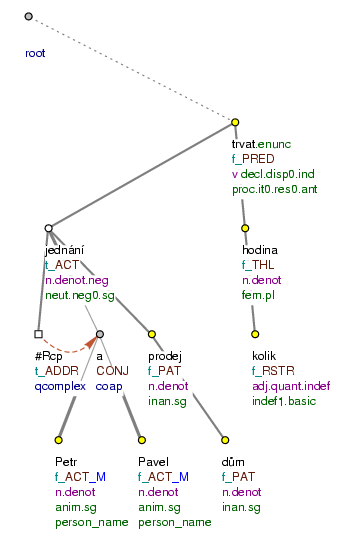
Jednání Petra a Pavla o prodeji domu trvalo několik hodin. (=lit. Negotiation (of) Petr and Pavel about selling (of) house took several hours)
The prepositional phrase mezi+7 (which is understood as a signal that there is a reciprocal relation between certain modifications of a noun) Section 2.4.2.1, "Valency frames and reciprocity") may also occur in verbal constructions potentially involving reciprocity; this concerns both periphrastic and reflexive passive constructions.
It holds that:
-
the reflexive passive constructions are primarily used with the general Actor; reciprocity is not represented in this kind of construction. The prepositional phrase mezi+7 is considered to be a locative adjunct in these constructions (it is assigned the
LOCfunctor); it is not analyzed as occupying the Actor position. The nodes inserted into the structure in the position of the Actor and the other member of the potentially reciprocal relation have the#Gent-lemma.Examples:
S ropou se obchoduje i mezi státy.
LOCEvropské unie. {#Gen.ACT} {#Gen.ADDR} (=lit. With oil REFL trades also between states (of) EU)Mezi hráči.
LOCse diskutovalo o tom, zda trenér očekává návštěvu sparťanského prezidenta. {#Gen.ACT} {#Gen.ADDR} (=lit. Between players REFL discussed about that whether trainer expects visit (of) Sparta's president)!!! We assume that, in the future, it might be appropriate to represent also the reciprocal relations between general Actors and other arguments in the tectogrammatical trees.
-
the periphrastic passive constructions do not exclude the overt presence of the Actor. The prepositional phrase mezi+7 may be a signal that there is a reciprocal relation between the Actor and one of the other valency modifications.
However, it seems that if there is a reciprocal relation in a periphrastic passive construction, the predicate in passive is in fact a complex predicate (see Section 9.3, "Complex predicates"). The prepositional phrase mezi+7 is, then, considered a formal means of expressing the reciprocal relation between some of the valency modifications of the noun that constitutes the nominal part of the complex predicate (not between the arguments of the verb itself; cf. Fig. 6.11).
The present section describes individual rules for representing valency in the tectogrammatical trees. The rules concern the following areas:
-
representing valency of words with competing valency modifications (see Section 2.4.3.1, "Representing the valency of verbs with competing valency modifications"),
-
problems with assigning the appropriate valency frames to nouns (see Section 2.4.3.2, "Problematic cases w.r.t. the representation of the valency of nouns"),
-
functors assigned to non-valency modification of nouns referring to events (see Section 2.4.3.3, "Functors assigned to the non-valency modifications of nouns referring to events"),
-
pronouns in place of words with valency (see Section 2.4.3.4, "Pronouns in place of words with valency").
Also for complex predicates, there are special rules concerning their valency representation; for these, see Section 9.3.4, "Representation of the valency of complex predicates in the tectogrammatical tree".
Verbs with competing valency modifications and their valency frames are discussed in Section 2.3.1.5, "Valency modifications competing for the same position (while the meaning of the verb is preserved)".
Representing the valency of verbs with (some of the) valency modifications competing for a single position. If a valency position can be occupied by more different modifications (with different functors), the valency requirements of the verb are satisfied if one of the competing modifications is present in the position.
In case none of these competing modifications is present at the surface level, a new node is inserted into the structure (t_lemma=#Oblfm). The newly established node gets the functor of the most general modification competing for the position. If an obligatory manner adjunct is missing at the surface level, the newly established node with the #Oblfm t-lemma is assigned the MANN functor.
Also when the verb with competing valency modifications is copied (e.g. in comparative constructions), the newly established node in the valency position of the copied verb to which more different functors may be assigned gets the most general functor, regardless which functor was assigned to the modification in the construction from which the verb was copied. The rule is, then, that when inserting a new node in the position for which more different valency modification compete, the newly established node always get the most general functor (in case of competing modifications of the manner type, the assigned functor is MANN).
Cf.:
-
Dopadlo to ve prospěch sester.
BEN(=lit. Turned_out it in favour (of) sisters; meaning: The sisters benefited from the situation)The valency frame:
ACT(.1)MANN(*)|CRIT(*)|ACMP(*)|BEN(*)|CPR(*)The modification ve prospěch sester occupies the obligatory manner position (i.e. no node is inserted into the structure on the position; cf. Fig. 6.12).
-
Projevilo se to zvýšením.
MEANSinflace. (=lit. Showed/manifested REFL it by_increase (of) inflation; meaning: You could see that by the inflation rise)The valency frame:
ACT(.1)MANN(*)|CRIT(*)|ACMP(*)|BEN(*)|CPR(*)The modification zvýšením (inflace) occupies the obligatory manner position (i.e. no node is inserted into the structure on the position).
-
Ta vypadá. {
#Oblfm.MANN} (=lit. That.fem looks; meaning: She looks awful/so strange...)The valency frame:
ACT(.1)MANN(*)|CRIT(*)|ACMP(*)|BEN(*)|CPR(*)A new node with the
#Oblfmt-lemma and theMANNfunctor is inserted into the structure on the position of the obligatory manner adjunct (cf. Fig. 6.13).
-
Jedná s nadšením.
ACMPstejně jako já {jednat.CPR} {#Oblfm.MANN} (=lit. (He) acts with enthusiasm just like me)The valency frame:
ACT(.1)MANN(*)|CRIT(*)|ACMP(*)|BEN(*)|CPR(*)Since this is a comparative construction, the verb jednat is copied into the structure. The newly established node for the obligatory manner adjunct (i.e. the position for which more different modifications compete) has the
#Oblfmt-lemma and theMANNfunctor even though the same position with the original verb is occupied by a modification with theACMPfunctor (cf. Fig. 6.14).
Figure 6.12. Representing the valency of verbs with competing valency modifications
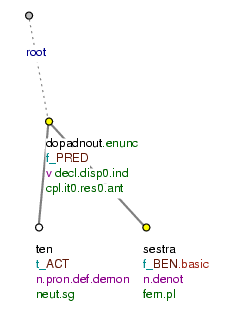
Dopadlo to ve prospěch sester. (=lit. Turned_out it for benefit (of) sisters)
Figure 6.13. Representing the valency of verbs with competing valency modifications
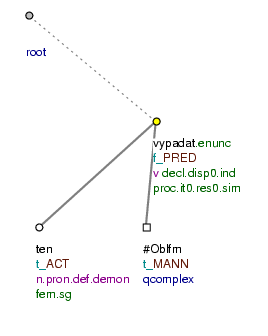
Ta vypadá. (=lit. She looks)
Figure 6.14. Representing the valency of verbs with competing valency modifications
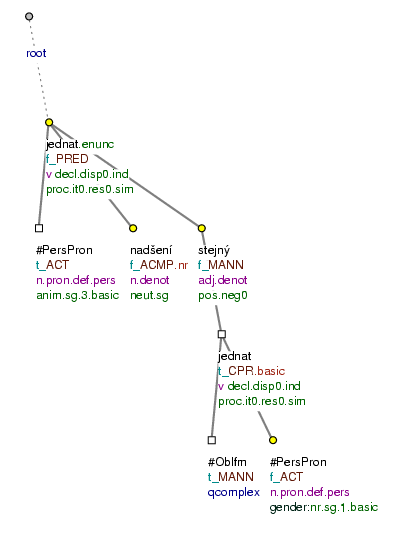
Jedná s nadšením stejně jako já. (=lit. (She) acts with enthusiasm just like me)
Representing the valency of verbs that have more valency frames for a single meaning. As for the verbs where the problem posed by competing valency modifications is solved by means of proposing different valency frames for the relevant meaning of the verb, the following rules apply:
-
if the modification in the position for which more different modifications compete is expressed at the surface level, the verb is assigned the valency frame corresponding to the expressed modification.
-
if none of the competing modifications is present at the surface level, there is no lead for choosing the appropriate valency frame. In this case, the following simple rules are to be followed:
-
if the competing modifications have one of the following functors:
ADDR,LOC,DIR3,DIR1, the valency frame with the Addressee is to be chosen (since arguments are higher in the hierarchy).The rule applies also in those cases in which both the Addressee and the locative/directional adjunct are present at the surface level; the verb is assigned the valency frame with the Addressee, the locative/directional adjunct is taken to be a non-valency modification.
-
in case the
LOCandDIR3modifications compete for the same position in the valency frames of verbs of "puting something somewhere" (at some place/to some place) or verbs of "taking up a place" or "changing a position", the valency frame with theDIR3modification takes precedence.This rule applies also to the cases when the obligatory locative/directional adjunct is expressed by a homonymous form (the one corresponding both to the question "where to (to what place)?" and "where (at what place)?") and when it is not possible to decide which of the two interpretations is more appropriate in the context (see also Section 4.3.1, "Borderline cases with the
DIR3functor"): the homonymous locative/directional adjunct is assigned theDIR3functor.
-
Cf.:
-
representing the valency of the verb podat (=submit), which has the following three valency frames for one of its meanings:
ACT(.1)CPHR({důkaz, informace, návrh, odvolání, oznámení, podnět, stížnost, výpověď, zpráva, žádost, žaloba,...}.4)ADDR(.3)ACT(.1)CPHR({důkaz, informace, návrh, odvolání, oznámení, podnět, stížnost, výpověď, zpráva, žádost, žaloba,...}.4)DIR3(*)ACT(.1)CPHR({důkaz, informace, návrh, odvolání, oznámení, podnět, stížnost, výpověď, zpráva, žádost, žaloba,...}.4)LOC(*)-
Včera jsem podal žádost na úřad.
DIR3(=lit. Yesterday (I) submitted/lodged application to institution)One of the competing valency modifications is expressed (present at the surface level). It is assigned the valency frame with the
DIR3modification. -
Včera jsem podal žádost. (=lit. Yesterday (I) AUX submitted application)
None of the competing valency modifications is expressed. The verb is assigned the valency frame with the
ADDRmodification. A new node is inserted into the structure in the position of the non-expressedADDRmodification (the choice of the appropriate t-lemma is governed by the rules described in Section 12.2, "Ellipsis of the dependent element"; cf. Fig. 6.15). -
Včera jsem na městském úřadě.
LOCpodal žádost kompetentnímu oddělení.ADDR(=lit. Yesterday (I) AUX at municipal authority submitted application (to) competent department)In this case, two of the competing modifications are expressed (present at the surface level). The verb is assigned the valency frame with the Addressee; the locative adjunct is considered a non-valency adjunct.
-
-
representing the valency of the verb umístit (=place), which has the following two valency frames for one of its meanings:
ACT(.1)PAT(.4)DIR3(*)ACT(.1)PAT(.4)LOC(*)-
Umístil křeslo v pokoji.
LOC(=lit. (He) placed armchair in room)One of the competing valency modifications is expressed (present at the surface level). The verb is assigned the valency frame with the
LOCmodification. -
Konečně je křeslo správně umístěno. {
#Oblfm.DIR3} (=lit. Finally is armchair correctly placed)None of the competing valency modifications is expressed. The verb is assigned the valency frame with the
DIR3modification. A new node is inserted into the structure in the position of the non-expressedDIR3modification; its t-lemma is#Oblfm(cf. Fig. 6.16). -
Umístil křeslo vedle skříně.
DIR3(=lit. (He) placed armchair next_to wardrobe)The form of the adjunct corresponds to both of the competing modifications (providing the answer for both the question "where to?" and "where?"); it is homonymous. If it does not follow form the context which of the meanings is involved in this particular case, the verb is assigned the valency frame with the
DIR3modification.
-
If a noun with valency requirements has no expressed valency modifications (or if only some of them are expressed), it may be impossible to decide which valency frame is to be assigned to the noun (this is due to the homonymy or even vagueness of the construction).
If the construction is ambiguous, it is up to the annotator to decide which interpretation is involved.
Agentive vs. agent-less constructions. Certain nouns can refer either to agentive or agent-less events: snížení (=decrease), šíření (=spreading), zvednutí (=rising/increase), zpevnění (=reinforcement), zpomalení (=slowing down), posílení (=strengthening/reinforcement); these are nouns that are derived either from active or their corresponding reflexive verbs.
Two valency frames are available for this type of nouns:
-
one for the agentive events:
ACT(.2,.7,.u)PAT(.2,.u). -
one for the agent-less events:
ACT(.2,.u).
In some case it is quite easy to tell whether the given event has an agent or whether there is no agent involved in the event; in other cases, however, the context does not help and it is impossible to decide what the right interpretation is. Cf.:
-
snížení cen.
PATna některé druhy zboží {#Gen.ACT} (=lit. decrease (of) prices for some kinds (of) goods)= agentive event
-
snížení hladiny.
PATřek (=lit. sinking (of) water_level (of) rivers)= agent-less event
-
snížení výkonu mužstva (=lit. descent/lowering (of) performance (of) team)
It is possible to interpret the construction in two different ways: either someone or something caused the fact the the current performance of the team is worse than it was before or the performance got worse by itself.
More ambiguous cases:
-
po zranění našeho brankáře (=lit. after injuring (of) our goal-keeper; i.e. after our goal-keeper was injured)
The construction can be interpreted in two ways: either the goal-keeper caused his injury himself or someone else injured him.
-
znehodnocení skladovaných léků (=lit. damage (of) stored drugs)
It is possible to interpret the construction in two different ways: either someone caused the damage or the drugs lost their value without anyone or anything causing it directly (e.g. due to being stored for too long).
-
zviditelnění samostatného slovenského státu (=lit. drawing_attention (to) independent Slovak state)
The construction can be interpreted in two ways: either someone or something drew attention to the Slovak republic or it happened by itself (without anybody causing it directly).
Problems caused by too subtle differences between the individual valency frames. Sometimes, different valency frames correspond to meanings between which there are only subtle differences. Without a sufficient context, it may be difficult to decide which valency frame is appropriate for a given noun token. Cf.:
-
valency frames of the noun vyjednávání (=negotiations):
ACT(.2,.u)PAT(o+6)ADDR(s+7)ACT(.2,.u)PAT(.2,.u)ADDR(s+7)Examples:
-
vyjednávání pracovních podmínek.
PATse zaměstnavatelem.ADDR(=lit. negotiating (of) working conditions with employer)The valency frame:
ACT(2,7,u)PAT(2,u)ADDR(s+7) -
vyjednávání o termínech.
PATdodávek s provozovatelem.ADDR(=lit. negotiating about dates (of) delivery with owner/operator)The valency frame:
ACT(.2,.u)PAT(o+6)ADDR(s+7) -
kolektivní vyjednávání trvá několik hodin (=lit. collective negotiations take several hours)
The construction can be interpreted in two ways.
-
-
valency frames of the noun vyprávění (=(story-)telling):
ACT(.2,.7,.u)PAT(o+6) ?ADDR(.3)ACT(.2,.7,.u)PAT(.2,.u) ?ADDR(.3)Examples:
-
vyprávění pohádek.
PAT(=lit. telling (of) fairy-tales)The valency frame:
ACT(.2,.7,.u)PAT(.2,.u) ?ADDR(.3) -
vyprávění o Africe.
PAT(=talking about Africa)The valency frame:
ACT(.2,.7,.u)PAT(o+6) ?ADDR(.3) -
podle vyprávění jednoho z hráčů (=lit. according to telling (of) one of players; i.e. one of the players' version of the story)
The construction can be interpreted in two ways.
-
Competing valency modifications of nouns. Cases of competing verbal valency modifications are discussed in Section 2.3.1.5, "Valency modifications competing for the same position (while the meaning of the verb is preserved)". Competing valency modifications may be found with (deverbal) nouns as well. Cf.:
-
valency frames of the noun podání (=submission):
ACT(.2,.7,.u)PAT(.2,.u) ?ADDR(.3)ACT(.2,.7,.u)PAT(.2,.u)DIR3(*)Examples:
-
podání daňového přiznání finančnímu úřadu.
ADDR(=lit. submission (of) tax return tax office.DAT)The valency frame:
ACT(.2,.7,.u)PAT(.2,.u) ?ADDR(.3) -
podání daňového přiznání na finanční úřad.
DIR3(=lit. submission (of) tax return to tax office)The valency frame:
ACT(.2,.7,.u)PAT(.2,.u)DIR3(*) -
31. března končí termín pro podání daňového přiznání. (=lit. 31st March ends limit for submission (of) tax return)
The construction can be interpreted in two ways.
-
-
valency frames of the noun umístění (=placing):
ACT(.2,.7,.u)PAT(.2,.u)LOC(*)ACT(.2,.7,.u)PAT(.2,.u)DIR3(*)Examples:
-
umístění dětí v dětských domovech.
LOC(=lit. placing children in children's homes)The valency frame:
ACT(.2,.7,.u)PAT(.2,.u)LOC(*) -
umístění dětí do dětských domovů.
DIR3(=lit. placing children into children's homes)The valency frame:
ACT(.2,.7,.u)PAT(.2,.u)DIR3(.3) -
o budoucím umístění prodejny se vedou spory (=lit. about future placement (of) shop is_debated)
The construction can be interpreted in two ways.
-
!!! The rules telling which valency frame should be chosen in ambiguous cases (see Section 2.3.1.5, "Valency modifications competing for the same position (while the meaning of the verb is preserved)") do not apply in nominal constructions (so far). The decision in ambiguous cases rests with the annotator.
Non-valency modifications of deverbal nouns referring to events (see Section 2.3.2.4.1, "Valency frames of nouns referring to events") are assigned functors they would get if they modified the corresponding verb. Hence, if a noun is assigned an eventive valency frame, all modifications of the noun (including agreeing adjectival modifiers) are assigned functors of (ad)verbal modification. Cf.:
-
dvě.
THOvčerejší.TWHENjednání parlamentu.ACTo daních.PAT(=lit. two yesterday's negotiations (of) Parliament about taxes)= Parlament včera dvakrát jednal o daních. (=The Parliament negotiated about the taxes twice yesterday)
-
dvě.
THOvčerejší.TWHENzásadní.MANNrozhodnutí vlády.ACT(=lit. two yesterday's principal decisions (of) Government)= The Government made two fundamental decisions yesterday (cf. Fig. 6.17)
-
přirozené.
MANNvybírání (=lit. natural selection)= přirozeně vybírat (=to select naturally)
More examples:
zdejší.LOC výskyt (=lit. local incidence)
tehdejší.TWHEN pobyt ve východní Evropě (=lit. that_time's stay in Eastern Europe)
letošní.TWHEN příchod zimy (=lit. this_year's arrival (of) winter)
poslední.TWHEN jmenování (=lit. last appointment (to a function))
vysoké.EXT zatížení (=lit. high load)
The nominal functor RSTR is only assigned to a modification of such a noun in the following cases:
-
if the noun is modified by the following pronouns: ten, tento, onen, některý, nějaký, žádný.
For example:
tato.
RSTRvčerejší.TWHENhlasování parlamentu.ACT(=lit. this yesterday's voting (of) Parliament)ono.
RSTRposkakování (=that jumping) -
if the noun is modified by an adjective to which it is hard to assign a verbal modification functor.
For example:
určitá.
RSTRjednání parlamentu.ACT(=lit. certain negotiations (of) Parliament) -
if the noun is modified by a relative clause.
For example:
tato.
RSTRhlasování parlamentu.ACT, která se uskutečnila.RSTRvčera. (=lit. these votings (of) Parliament that took_place yesterday) Fig. 6.18
NB! Agreeing adjectival modifiers (with the exception of possessive adjectives and pronouns) are not considered arguments; they are assigned adjunct functors; e.g.:
soudní.MANN rozhodnutí (=lit. court's decision) Fig. 6.19
!!! Non-valency modifications of nouns (referring to events) in the form of agreeing adjectives are assigned functors for verbal adjuncts consistently only in the case of verbal nouns (i.e. those ending with -ní or -tí) and mostly only in the case of the TWHEN modification. In other cases, the agreeing adjectival modifiers are often assigned the RSTR functor.
Figure 6.17. Representing the valency of nouns referring to events
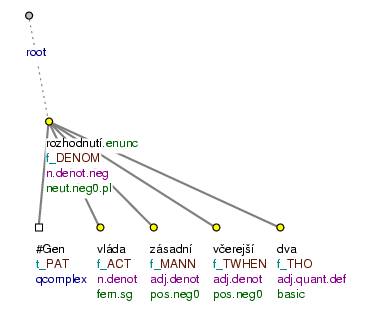
dvě včerejší zásadní rozhodnutí vlády (=lit. two yesterday's essential decisions (of) government)
Deictic words may stand in coreference relations with words that have valency requirements (usually nouns). Then, the deictic word inherits the valency properties of the co-referred word. Hence, valency modifications of these co-referred words may modify the deictic words.
These are mainly cases of relative pronouns (in relative clauses) co-referring with nouns with valency requirements. There is a grammatical coreference relation between the relative pronoun and the corresponding noun, which is marked in the tectogrammatical tree (see Section 2.2, "Coreference with relative elements"). However, there may be also cases of textual coreference.
The node for the co-referring pronoun is assigned the same functor as the co-referred word would get in its position (it can also be CPHR or DPHR). If the clause containing the co-referring pronoun contains a valency modification of the coreferred word, this valency modification depends on the co-referring pronoun node and it is assigned a functor according to the valency frame of the co-referred word. For those obligatory valency modifications of the co-referred word that are not present at the surface level (as modifications of the relative pronoun), new nodes are inserted into the structure only in the case they are involved in grammatical coreference relations.
The pronoun itself is assigned no valency frame. Only the co-referred word is assigned a valency frame.
Cf.:
-
Vliv, který.
CPHRmají na situaci.PAT, je velký. (=lit. Influence which (they) have on situation is big)The relative pronoun který in the relative clause refers to the noun vliv (=influence) which has the following valency frame:
ACT(.2;.u)PAT(na+4). There is a grammatical coreference relation between the relative pronoun který and the noun vliv, which is marked in the tectogrammatical tree (see Section 2.2, "Coreference with relative elements").The relative pronoun který is assigned the
CPHRfunctor (mít vliv (=have influence) is a complex predicate; see Section 9.3, "Complex predicates"). The prepositional phrase na situaci (=on the situation) is the Patient of the noun vliv; its node depends on the node for the relative pronoun který and its functor isPAT. A new node with the#PersPronis inserted into the structure as a dependent node of the node for the noun vliv; there is a textual coreference relation marked between the node for the Patient na situaci and the newly established node (cf. Fig. 6.20). -
(Začínáme upomínkami, těch bylo vloni asi osm set, a končíme soudními žalobami. (=We start with reminders, there were about eight hundred reminders last year, and end with legal actions.) Bylo jich.
CPHRpodáno na sedmdesát. (=lit. Was of_them lodged about seventy; i.e. there were about seventy of them)The pronoun on refers to the noun žaloba (=legal action). There is a textual coreference relation between the pronoun on and the noun žaloba, which is marked in the tectogrammatical tree (see Section 2.2, "Coreference with relative elements"). The pronoun on is assigned the
CPHRfunctor (podat žalobu (=take legal action) is a complex predicate; see Section 9.3, "Complex predicates").
More examples:
Zájem, který.CPHR rolníci projevují o kurzy.PAT , není malý. (=lit. Interest which farmers show for courses is not small)
Válečnou sekeru, kterou.DPHR včera zakopali, dneska zase vykopali. (=lit. Battle-axe which (they) yesterday buried, today again took up)
